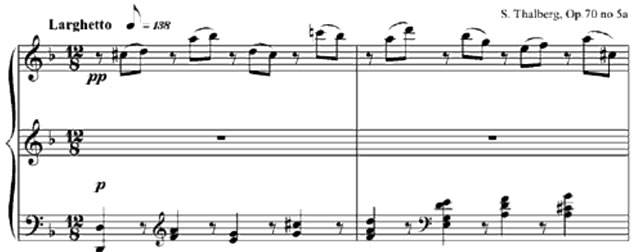CD-recensie
© Gerard van der Leeuw, december 2020
Thalberg: L'Art du Chant appliqué au piano op. 70 Paul Wee (piano) |
Op het BIS-label verscheen onlangs een dubbel-cd met Thalberg’s complete l’Art du chant appliqué au piano op. 70, meesterlijk gespeeld door de in Londen werkzame advocaat Paul Wee.
Uit de door de pianist zelf geschreven toelichting:
Sigismond Thalberg (1812–71) was one of the pre eminent figures of nineteenth-century pianism, heralded as the only serious rival (if not the outright equal) to Liszt in his prime. Born on 8th January 1812 in Pâquis (Geneva) and reputed to be the illegitimate son of Franz Joseph, Prince of Dietrichstein, and Baroness Maria Julia Wetzlar von Plankenstern, Thalberg embarked on early studies in London and Vienna before enjoying a meteoric rise to fame upon arriving in Paris in the 1830s. Such was the furore created by his playing that the Parisian musical press fomented a ‘rivalry’ between Thalberg and Liszt, who had between them uniquely captured the adulation of the concert-going public at large (unlike Chopin, who disdained the concert hall, or Alkan, who seemingly did not wish to pander to the musical tastes of the Parisian bourgeoisie, and was shortly to withdraw from the concert stage). The press was aided and abetted in this by Liszt himself, who (among other indiscretions) illadvisedly authorised the publication in his own name of a deprecatory review in the Revue Musicale deriding Thalberg’s music (which had actually been penned by his then-partner, Comtesse Marie d’Agoult). Though he did not stoop to responding in print, Thalberg was not without riposte. Faced with a suggestion that he and Liszt should give a joint concert, Thalberg reportedly quipped: ‘I do not like to be accompanied.
L’art du chant bestaat uit een groot aantal voor de piano bewerkte vocale composities, opera, liederen en oratoria, van componisten als Stradella, Grétry, Haydn, Mozart, Beethoven, Meyerbeer, Weber, Schubert, Bellini en Rossini. Bewerkingen waarin hij meesterlijk gebruik maakt van ‘de derde hand’, de door Thalberg ontwikkelde techniek om met de duimen van beide handen om beurten de melodie van het werk in kwestie te spelen.
In het voorwoord van uitgever Heugel bij de uitgave van 1853 staat precies wat Thalberg beoogde:
Le seul nom de S. THALBERG attachéé à cette nouvelle et grande publication: l’Art du Chant appliqué au Piano, donne la mesure de son importance et de son utilité. À une époque où des milliers de jeunes pianistes possèdent une dextérité de doigts inimaginable, il n’est pas sans intérêt de les rappeler à la véritable mission du simple et du beau, celle de charmer et non d’étonner l’auditoire, de jouer moins pour les yeux, plus pour le coeur.
En dat is het precies. Virtuositeit staat hier niet voorop. Kijk eens
naar het begin van Thalbergs bewerking van Mozarts Lacrymosa
uit het Requiem:
 |
Kan het eenvoudiger?
Thalberg blijft steeds trouw aan de componist die hij bewerkt. Vergelijk bijvoorbeeld eens zijn versie van Beethovens Adelaide met die van Liszt. Liszt maakt er een effectief showstuk van, bij Thalberg hoor je het lied van Beethoven. Nogmaals Paul Wee:
As to how the art of singing could be realised on the piano, Thalberg was fully aware that the piano, being a percussion instrument, cannot be made to sing per se. His preface to L’art du chant acknowledges immediately that ‘rationally speaking, the piano cannot recreate the beautiful art of singing at its most perfect, as it lacks the ability to sustain a tone.’ Since a note struck on the piano inevitably decays, and cannot be sustained indefinitely or made to swell, Thalberg knew that the solution had to lie in illusion: ‘it is therefore necessary to overcome this through skill and artifice, by producing the illusion not only of sustained and prolonged sounds, but also that of swelling sounds.’ Thalberg was, of course, a famed master of pianistic illusion. But here, his powers of ingenuity were not directed at overcoming the limitations of the pianist, by creating the illusion of a third hand playing. Instead, Thalberg’s (much more radical) aim in L’art du chant was to transcend the inherent limitations of the piano itself.
Dit is een grandioze uitgave. Paul Wee mag dan advocaat wezen, hij steekt menig pianovirtuoos in zijn zak. De Steinway zingt. Hier is een monument opgericht voor Thalberg. Wat de kenners van zijn prachtige pianotrio op. 69 eigenlijk allang wisten wordt hier weer eens bewezen: Thalberg is veel meer dan een allang vergeten piano-virtuoos. Hij is een groot kunstenaar.